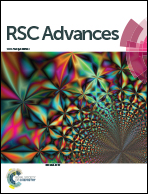Converting obsolete copy paper to porous carbon materials with preeminent adsorption performance for tetracycline antibiotic†
Abstract
To date, the employment of developed adsorbents in antibiotic wastewater treatment practices is still limited due to their low adsorption capacity, slow kinetics and especially high cost. Thus, in this work, we first report the conversion of obsolete copy paper to highly porous carbon materials (PCMs) via a two-step method: low-temperature carbonization and alkali activation. The influence of activation temperature and KOH content on the porosity and adsorption capacity of PCMs was also studied. Notably, copy paper (CP) is consumed in extremely large quantities with a high proportion being obsoleted; it mainly consists of micro- and nano-cellulose fibers that can be used as an ideal carbon source. The PCMs were characterized by several techniques and methodologies. The PCMs-850-4 exhibited an ultrahigh BET surface area of 3598.95 m2 g−1 and total pore volume of 1.887 cm3 g−1. The influence of temperature, initial concentration, contact time, pH and ionic strength on the adsorption of tetracycline (TC) from water to PCMs-850-4 was investigated through batch adsorption studies. Analyses of adsorption isotherm, kinetics and thermodynamics property were conducted to understand the adsorption behavior. The equilibrium experimental data was well fitted to the Langmuir model, and the kinetic data was best described by the pseudo-second-order rate model. Importantly, the PCMs-850-4 displayed an ultrahigh adsorption of 1437.76 mg g−1 at 298 K, and increasing temperature benefited the adsorption. Also, their fast kinetics and great regeneration make the PCMs-850-4 a promising adsorbent for the low-cost, highly efficient and fast removal of organic pollutants from water environments.


 Please wait while we load your content...
Please wait while we load your content...